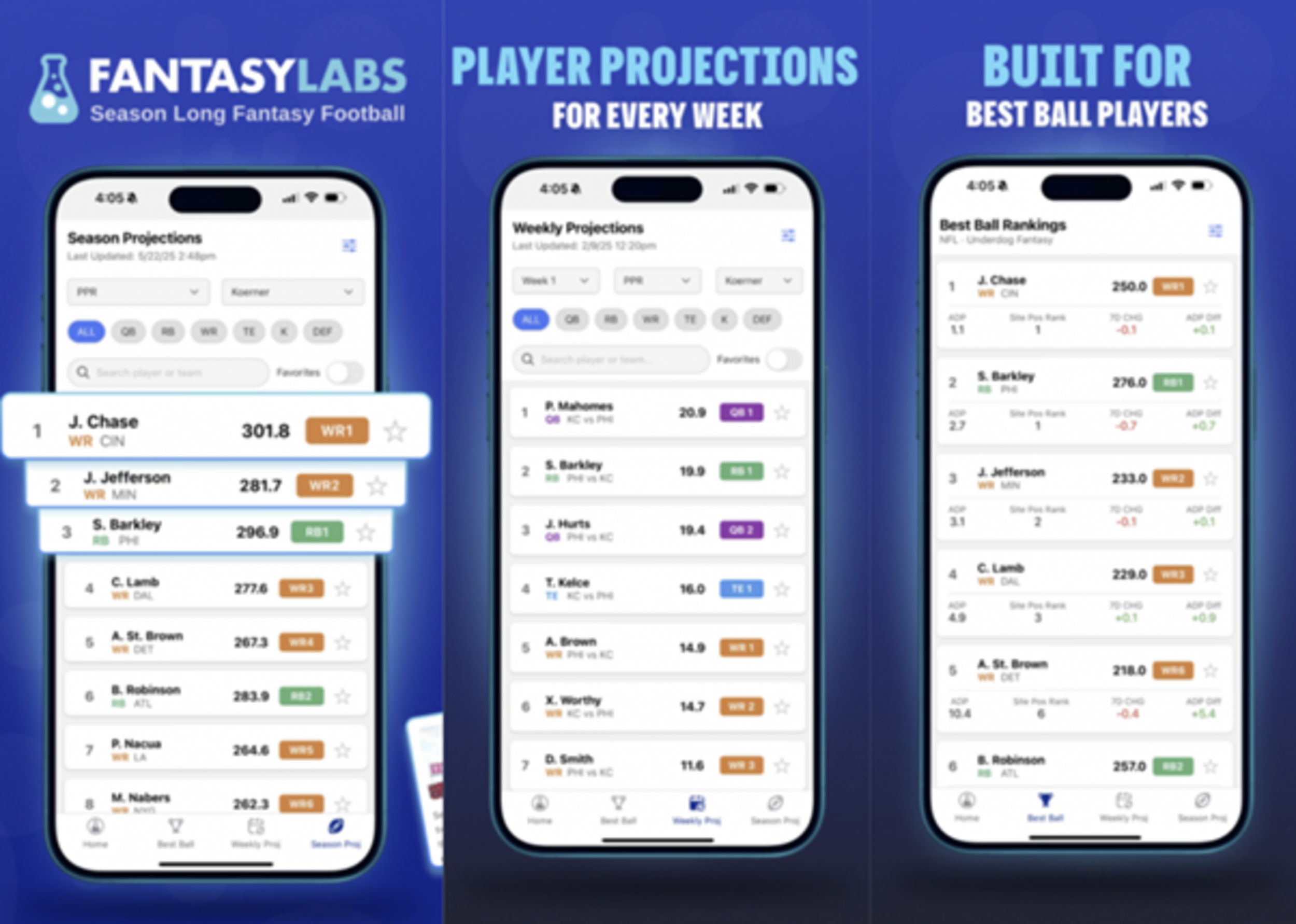
TE Premium Draft Strategy explained: Top fantasy football targets for 2025
Tight end (TE) premium scoring is becoming increasingly popular in the fantasy football world as a way to add value to a position that is often overlooked during roster construction. In these formats, scoring bonuses for tight ends can range from 1.25 points per reception all the way up to 2.0 points per catch. The larger the bonus, the greater the advantage of locking in a productive starting tight end—and possibly even using one in a flex spot—when chasing a fantasy championship.
Below is an in-depth analysis, including players who fit an effective tight end premium draft strategy that you can target this season, whether it be re-draft leagues at Sleeper Fantasy or Underdog Best Ball drafts.
And don't forget to sign up for your fantasy football league on Yahoo Sports!
What is the TE Premium Strategy?
In TE premium formats, the foundation of draft strategy comes from recognizing how much more valuable elite tight ends are compared to standard leagues. Because receptions carry extra weight at the position, top players like Brock Bowers and Trey McBride can deliver a significant weekly edge. In leagues awarding 2.0 points per tight end reception, Bowers scored more than every receiver and running back last season except Ja'Marr Chase.
This scoring gap makes it worthwhile to invest early in one of the elite options rather than waiting, since the difference between top-tier tight ends and the middle group is usually far larger than what you’ll see at other positions. Securing one of these impact players provides both a steady weekly floor and a ceiling high enough to anchor a roster.
If you miss out on that top tier, the best alternative is to use a “two-punch” approach later in the draft: grab two upside options instead of settling for one mediocre starter. By doing this, you can still take advantage of premium scoring by betting on athletic breakout candidates or experienced players in high-volume passing attacks. The key is staying flexible—don’t reach if the value isn’t there. Manage your roster needs carefully, but remember that in TE premium formats, tight ends produce closer to high-end wide receivers, making them worth targeting earlier and more often than in traditional leagues.
Use promo code YARD20 for $20 off your FantasyLabs fantasy football subscription!

Pros of the TE Premium Draft Strategy
The main advantage of a TE premium draft strategy is that it lets managers take full advantage of the scarcity at the tight end position. In most formats, only a small group of tight ends consistently put up strong weekly numbers, and premium scoring makes those players even more valuable. Grabbing one of them early not only secures a dependable weekly difference-maker but also provides a scoring edge over opponents who are stuck relying on replacement-level options.
Another benefit of this approach is the added flexibility and upside it brings to roster construction. With premium scoring putting tight ends on more equal footing with wide receivers and running backs, managers can load up on multiple tight ends without weakening the rest of their roster. This creates room to stash breakout candidates or flip them later in trades, since tight ends carry higher value in these formats. On top of that, holding versatile, high-upside options can give you an edge in flex spots, where tight ends often outproduce mid-tier wideouts or backs. The result is not only a stronger starting lineup but also improved depth and long-term roster versatility.
Dominate your Best Ball and season-long fantasy football leagues with FantasyLabs’ brand-new app that's available in the Apple App Store and on Android!

Cons of the TE Premium Draft Strategy
One of the biggest downsides to a TE premium draft strategy is the possibility of overspending on the position at the cost of building strength elsewhere. While elite tight ends can create a weekly advantage, using an early pick on one usually means passing on a top running back or wide receiver who could end up being just as critical to your roster. If that tight end underperforms, deals with injuries, or sees reduced usage in their offense, the opportunity cost can leave your team weak at positions that generally drive the bulk of fantasy scoring. In other words, the push to secure “your guy” early can backfire if it throws your roster out of balance.
Another drawback is that beyond the elite tier, tight end production remains unpredictable—even in premium formats. Many mid-tier options are touchdown-dependent for their fantasy value, and despite the added reception points, their week-to-week output can be inconsistent. This makes them tough to trust as starters over other flex candidates, and carrying multiple tight ends to protect against that risk takes up valuable roster spots. On top of that, TE premium leagues often inflate the price of the position in both drafts and trades, which can make it harder to find value or pivot strategically compared to managers who focus resources on more stable player pools like wide receivers or running backs.
Best Ball rankings from some of the top industry experts are also available on FantasyLabs.

Top Elite TE Premium Targets in 2025
Brock Bowers, QB, Las Vegas Raiders
After his record-setting rookie campaign, the debate around Brock Bowers in 2025 isn’t about whether he belongs among the elite tight ends, but rather how early fantasy managers will need to draft him in TE premium formats. The former Georgia Bulldog topped all NFL tight ends with 112 catches in 2024, despite dealing with inconsistent quarterback play for much of the year.
His usage aligned with some of the league’s top wideouts, earning 153 targets—nearly identical to Justin Jefferson (154) and Garrett Wilson (154)—over 17 games. In standard PPR scoring, Bowers finished just 0.2 points per game behind George Kittle. But in leagues with full 2.0 points per tight end reception, Bowers outpaced Kittle by more than a full point per game. That kind of production makes him a clear first-round choice in heavy TE premium formats, with a real argument for top-5 draft capital as one of the rare players who create a true positional edge.
Trey McBride, TE, Arizona Cardinals
Rounding out the obvious elite tier in TE premium leagues is Trey McBride, the only other tight end besides Bowers to record 100 catches last season. McBride narrowly edged out Bowers in 2024 scoring by 0.1 points per game and continues to solidify his role as one of the position’s most consistent weapons.
His growth is clear, with target totals climbing each of his three years in Arizona: 34 as a rookie, 106 in year two, and 147 in year three. Preseason concerns that rookie Marvin Harrison Jr. might cut into his volume proved unfounded, as Kyler Murray leaned heavily on McBride throughout the campaign. If he can add more touchdowns to his stat line—he found the end zone just twice last year—McBride has the upside to deliver round-one level production in TE premium formats and further establish himself as a cornerstone fantasy asset.
Check out Sean Koerner's TE Tiers article to see how he stacks up all the tight ends this draft season.
Top Mid-Round TE Premium Targets in 2025
Colston Loveland, TE, Chicago Bears
Rookie tight ends always come with risk in fantasy drafts, particularly in TE premium formats, but recent seasons have shown that first-year players can succeed at the position. Brock Bowers, Sam LaPorta, Dalton Kincaid, and even Kyle Pitts all delivered meaningful production right out of the gate.
Colston Loveland proved himself as Michigan’s top receiving threat in recent years, showing polish as a route runner. Now in Chicago, he steps into a crowded offense with Rome Odunze, DJ Moore, Luther Burden, and Cole Kmet all competing for opportunities. FantasyLabs consensus projections place Loveland ninth among tight ends in expected targets this year. If he develops into Caleb Williams’ security blanket, he could benefit from soft coverage as defenses focus on containing the Bears’ vertical weapons.
Zach Ertz, TE, Washington Commanders
To the surprise of many, Zach Ertz continues to carve out fantasy relevance instead of fading into retirement. Last season, he clicked with rookie quarterback Jayden Daniels in Washington, finishing sixth among tight ends in receptions (66) and fourth in touchdowns (4).
Ertz currently occupies the wide middle tier of “startable” tight ends. According to FantasyLabs projections, 11 tight ends are expected to land between 50–59 receptions in 2025, making the mid rounds of TE premium drafts a value-hunting zone. At 34 years old, draft rooms may let Ertz slide, but he still carries sneaky upside. In full 2.0 TE premium scoring, his 2024 production would have ranked as the 10th-best wide receiver, highlighting how useful he can be in this format.
More must-reads:
- 25 fantasy football sleepers you should target at your draft
- Projecting top five fantasy football WRs for 2025: Can Ja'Marr Chase repeat?
- The 'Season TD pass leaders by NFL team' quiz
Breaking News
Trending News
Customize Your Newsletter
 +
+
Get the latest news and rumors, customized to your favorite sports and teams. Emailed daily. Always free!








